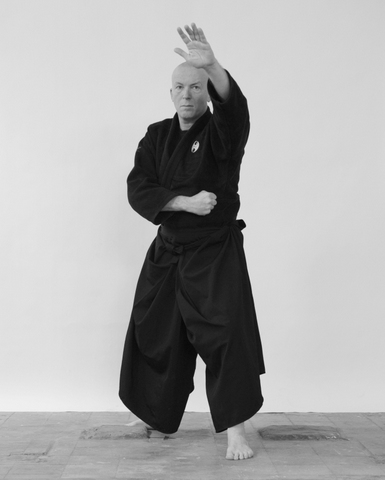Ninja
Ninja (忍者, נינג'ה). also called Shinobi (忍び), is the name of Japanese warriors from the Kamakura and Edo period that used a syllabus of fighting, guerrilla and counterintelligence skills.
Modern day accredited schools, mainly those belonging to the Takamatsu den - Bujinkan, Jinenkan, Genbukan and Akban, teach only parts of the vast Ninjutsu syllabus, thus focusing mainly on self-defense, kata practice and movement.

For an extensive Ninjutsu techniques list and videos go to the Ninjutsu techniques portal
Ninjas supposedly used the most advanced military technology of their times, survival, sabotage, psychology, spying, military intelligence, witchcraft, weather prediction and human intelligence networks.
The term Ninja is now used and known outside the Japanese culture and has come to depict, in international culture and media, a maverick warrior and an ingenious person. [1], [2]
Overview
Covert military techniques have been used extensively in Japan at the Sengoku period (戦国時代 Sengoku jidai) A.K.A Warring States period. The Ninja formed a caste made of several groups of socialized warriors. These groups concentrated their activity on the mountainous and hard to reach Iga and Koga provinces.
Several models of operation of these communities existed, from purely militaristic unit under the command of a Samurai Daimyo to self-governed villages that used to outsource skills when these were needed.
Historically in fighting[3] there was no clear line to differentiate a Ninja applying Ninjutsu skills from regular Samurai class warrior. Persons belonging to the Ninja class were involved in regular, battlefield, fighting while samurai soldiers and their Daimyo often performed military tasks that involved concealment, spying and surprise attacks that were clearly Ninjutsu.

The inter cultural influence of the Shugendo mountain religion and its esoteric practices influenced not only the historical Ninja but it's knowledge has been preserved to this day as evidenced in the [stances], formulations and practices in modern day Ninjutsu[4].
The scientific attitude of research and pioneer use of chemistry, botany and physics was documented on special scrolls that preserved, to this day, the scope of the Ninja endeavor.
Ninja were quick to adopt any military technique to their missions. The variety of Ninja tools and weapons that has been found in archaeological research is vast, and while some of it decayed or found its way into private hands of collectors, many of the technological finds reside in two museums in Japan.
Governed by strict discipline[5], the Ninja have augmented this military and infiltration knowledge with spiritual conditioning obtained from Yamabushi priests who practiced Shugendo at these same regions.
Ninja apparel and clothes
The color black, associated with the Ninja was allegedly used to help night time infiltration and camouflage. However, the dark color of navy blue was much more common and it was probably used to the same extent, if not more.
Existing ninja costumes are influenced from the theatrical representation of the ninja in the Japanese theater. One theory finds the origins of the so called black Ninja costume in the clothes of the stage hands that move things on stage while the play is going. In the Japanese theater these black clad stage hands are ignored by the viewers and so the black costume has evolved to symbolize invisibility.
The actual use of clothes within the Ninjutsu clans varied and was identical to the clothes of regular professionals and farmer. Being able to blend in a civil environment played a major part in the necessary ease of mobility in the Ninja’s actions.
The historical attire of the Ninja used the garb of several castes and professions that traveled a lot. The Komuso - priest who carried a ceremonial weapon and covered his face, was an ideal cover and so was the dress of a master merchant.The Sarugaku, a street actor's guild, and several other mobile professions were also used.
Footnotes
- ↑ https://boingboing.net/2014/09/13/radical-librarianship-how-nin.html
- ↑ https://www.simplyhired.com/k-ninja-engineer-jobs.html
- ↑ [1]; ON THE NATURE OF WAR, Carl von Clausewitz
- ↑ Ninjutsu:The Art of Invisibility (Google Books)
- ↑ Turnbull 2003, pp. 5–6
| This article is an Akban wiki still-in-progress page. > |
